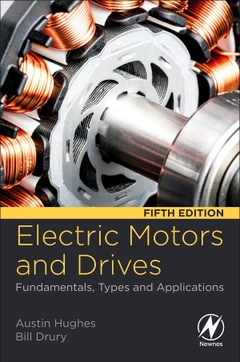Description
Electric Motors and Drives (5th Ed.)
Fundamentals, Types and Applications
Authors: Hughes Austin, Drury Bill
Language: English
Subject for Electric Motors and Drives:
Keywords
Electrical; engineering; power; motors; drives; transformer; induction; analysis; circuit; performance; inductor; control; modelling; technique; technology; measurement; design; application; traction; AC; DC
511 p. · 15x22.8 cm · Paperback
Description
/li>Contents
/li>Readership
/li>Biography
/li>Comment
/li>
Electric Motors and Drives: Fundamentals, Types and Applications, Fifth Edition is intended primarily for non-specialist users or students of electric motors and drives, but many researchers and specialist industrialists have also acknowledged its value in providing a clear understanding of the fundamentals. It bridges the gap between specialist textbooks (too analytical for the average user) and handbooks (full of detail but with little insight) providing an understanding of how each motor and drive system works.
The fifth edition has been completely revised, updated and expanded. All of the most important types of motor and drive are covered, including d.c., induction, synchronous (including synchronous reluctance and salient Permanent Magnet), switched reluctance, and stepping. There has been significant innovation in this area since the fourth edition, particularly in the automotive, aircraft and industrial sectors, with novel motor topologies emerging, including hybrid designs that combine permanent magnet and reluctance effects. We now include a physical basis for understanding and quantifying torque production in these machines, and this leads to simple pictures that illuminate the control conditions required to optimise torque. The key converter topologies have been brought together, and the treatment of inverter switching strategies expanded.
A new chapter is devoted to the treatment of Field Oriented control, reflecting its increasing importance for all a.c. motor drives. A unique physically-based approach is adopted which builds naturally on the understanding of motor behaviour developed earlier in the book: the largely non-mathematical treatment dispels much of the mystique surrounding what is often regarded as a difficult topic.
1. Electric motors – the basics 2. Introduction to power electronic converters for motor drives 3. Conventional D.C. Motors 4. D.C. Motor drives 5. Induction motors rotating field, slip and torque 6. Induction motor – operation from 50/60 hz supply 7. Variable frequency operation of induction motors 8. Field oriented control of induction motors 9. Synchronous, permanent magnet and reluctance motors and drives 10. Stepping and switched reluctance motors 11. Motor/drive selection
Bill Drury is an independent consultant in power electronics, electrical machines and drives (PEMD). He has 45 years industrial PEMD experience - Siemens, Rolls-Royce and for 20 years Technical Director of Control Techniques. He is a Chartered Engineer and a Fellow of the Institution of Engineering and Technology (IET). He is a Visiting Professor of Innovation at Bristol University and a Visiting Professor at Newcastle University.
- Helps users acquire knowledge and understanding of the capabilities and limitations of motors and drives without struggling through unnecessary math and theory
- Presents updated material on the latest and most widely-used motors and drives, including brushless servo motors
- Includes additional diagrams and worked examples throughout this updated edition
- Includes a physical basis for the understanding and quantifying torque production




